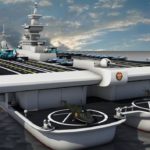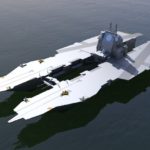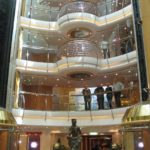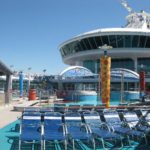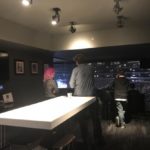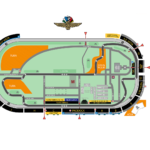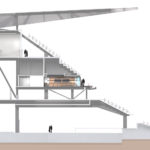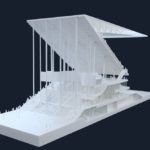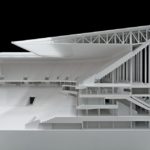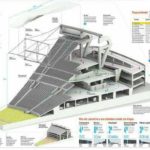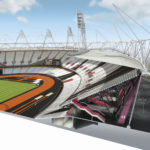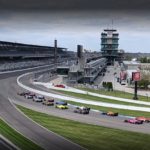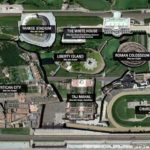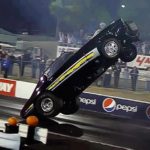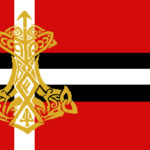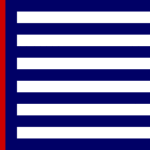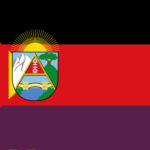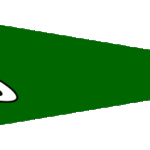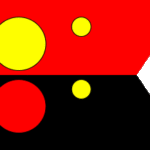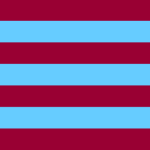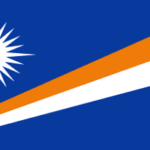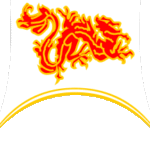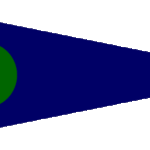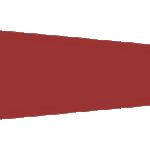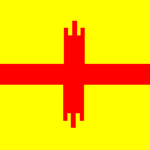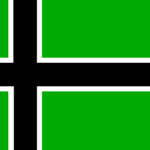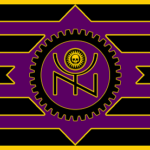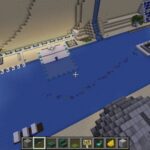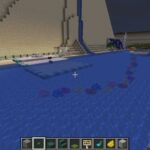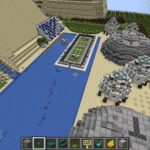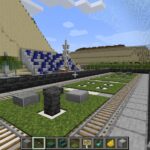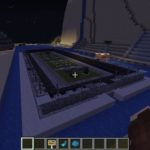We have two kinds of vehicle-based races in our city; street-races on our highway sections, and track races here.
–
Table of Contents:
- Intro
- Racing Vehicles
- Lodging
- Racing Types
- 2021 Update
- Overall (Images Begin)
- The Ship
- The Racetrack Stadium
- The Racecars and Related Vehicles
- The Girls
- Flags Along the Top of the Stadium
- 2023 Update: 2022 Scale-model in Minecraft
- 2024 May/+
–
Intro:
Based on the racetracks of the National Association for Stock Car Auto Racing (NASCAR), this automobile sporting arena is the next level; instead of being a track built within a stadium on the ground, Inisfree’s NASCAR track is built atop two custom oversized aircraft carriers fused together in the largest catamaran ever conceived.
With its two giant ships weighing in at 95,000 tons a piece (their weight comparable to normal thousand-foot-long carriers, thanks to being built with lighter, stronger materials), and the racetrack and stadium built atop it weighing in at about 10,000, this nearly 200,000-ton* sailing vessel is a force to be reckoned with.
(Thanks to the special/new material/s we made it with, it is actually nowhere near as heavy; it is closer to 10x less.)
Called the Double-carrier Racetrack, this ship passes through the four-stories-deep (40′) water of Inisfree’s main lake with little room to spare, but is Repulsine assisted, making its programmed circular route (~1 mile long, in a loop, with a diameter of just under 1/3 of a mile) possible and reliable.
Due to its design and low speed, paired with the Repulsine-assisted racing vehicles and ‘smart’-surface of the racetrack, racers do not have to compensate for the gravitational/momentum fluctuations otherwise felt due to choppy waters or changes in acceleration of the parent construct. (IOW: Even though this racetrack is floating/sailing around on our main lake, like being on a big cruise-ship, passengers and drivers alike pretty much won’t feel a thing, waves-wise.)
–
Racing Vehicles:
- NASCAR stock cars
- Formula 1
- Baja off-road racing trucks
- racing motorcycles such as “street bikes”
- a variety of other race-worthy vehicles
are all seen from time to time on this special, elevated, floating racetrack.
The track is easily converted back and forth between each of their needs.
Sometimes it will have a normal flat racetrack (for the normal racecars and street-bikes; racing motorcycles), and other times it will have “rugged terrain” simulating obstacles and jump-ramps (though the vast majority of our off-road driving/racing occurs at our Baja 500-inspired area.
–
Lodging:
Guests of these races typically fly in by way of their Owls (hover-saddles) or other small, personal aircraft, parking them in the parking spaces (more like landing pads for helicopters) which are all surrounded by landscaping and waterworks, such as small fountains from statues and flower pots.
Instead of stadium seating, guests are then helped to find their assigned convertible canopy bed (i.e. the canopy is retractable when shade from the Sun isn’t desired), and they may make use of the many VIP boxes –which all come complete with automatically-shading window-walls.
Guests staying overnight may use those VIP boxes as their hotel suites, but may also make use of the dozens of group berths and/or hundreds of single- and double-bed rooms below the flight/racetrack/topside deck.
There are no permanent guests here, though; this ship/racetrack is not for residents, only race spectators and staff.
–
Racing Types:
Several different kinds of vehicles, thus multiple types of races, are hosted here.
- Formula 1 (the jet-like low-riding racecars); 189.5 miles (305 km) worth of laps
- Motorcycles (street bikes); just a few laps… to as many as dozens (57 for one Outlands racetrack)
- NASCAR (best stock cars); distance/laps varies greatly from track/city to track/city
- Stock Cars (general/average; “any old” public-access production-model cars); however long these vehicles not made for racing can survive
- Tokyo Drift (street racers; mixed/custom); varies, mostly/more about drift ability (precision sliding turns) than endurance/laps
–
2021 Update:
Latest features now include:
- seating for ~250,000 human-sized spectators (as well as hotel suites for all of them)
- normal races, as well as practice drives/laps, are hosted here
- more than a dozen races here per year (and that’s just of the racecars)
- numerous restaurants lining the under-stands/seating walkways/halls
- numerous ‘toilet-rooms’ (what we in Inisfree call the rooms which Outlanders call bathrooms)
- ‘Firetanks‘ on standby in the middle of the track/field (with our naked firefighter-ICVs, of course)
- Air Traffic Control (ATC) towers (1 per corner of the ship/seating) guide / tractor-beam in all personal aircraft/seacraft
–2024 April note: This vessel has 5 of these towers; 1 at each corner for navigation and assistance, and the 5th in the stadium (to help keep the race/s safe –thus that innermost tower is not ATC, but GTC or RTC; Ground/Race Traffic Control) - small-yacht and mini-submarine bays along the sides of the hull at lake-level
- fireworks and laser-light shows at times
- street-racers welcome to practice here outside normal race times
- ICVs always drive/race naked, as they are indestructible anyway.
…
The original form of this racetrack was much smaller; it was atop two normal-sized abandoned/decommissioned/scrapped carriers we had taken from the Outlands, thus its racetrack/stadium was only 1,092′ (the ‘length’ (depth) of a carrier) x 512′ (the width of these two carriers side-by-side). That’s ~4.8 times shorter than the ‘length’, and ~4.9 times shorter than the width, of the Indianapolis Motor Speedway, resulting in a racetrack that was not the inspiration’s 2.5 miles long, but only ~half a mile long. After hosting numerous successful ICV-drivers races on that, we decided it had been our prototype for what we started building much better/bigger this year.
(The following paragraph was previous thinking based on trying to find a way of fitting a copy of the Indy 500 track into the main-lake’s area/end. The following estimate has since been updated; see one of the following sections after it.)
Because a normal aircraft carrier is only ~1,000′ long, in order to fit a racetrack on these two joined carriers that is comparable to the mile-long and half-mile wide Indianapolis Motor Speedway, much larger versions of aircraft carriers had to be built.
We coordinated a big group of our ICVs to 3D-print components for, and then assemble, this current version of our famous floating racetrack, both catamaran halves (oversized carriers) of which measure ~5 times a normal carrier’s length, and ~5 times their width (thus now each is ~5,300′ ‘long’ (deep) and ~1,260′ wide; this platform for our floating racetrack spans ~5,300′ x ~2,500′; 13,250,000 square feet across its joined/joint flight-deck –which is now a race-deck, not a flight-deck).
The result worked perfectly, and now has the same size/length racetrack on it as the Indianapolis Motor Speedway, but is so big that it no longer sails in a slow circle around the Venetian Lake Apartments, as it can only barely fit between them and our main lake’s beaches/shoreline, so we keep it floating with repulsines assistance during races, and, when there are no races being hosted upon it, in place (anchored/stationary) near the wet sands where our ColonyPods do their practice landings, still keeping half a mile of our main lake’s waters open for any swimming or sailing use between this racetrack’s side and where the Governor’s Mansion‘s cliff waterfall stream-delta fans out into this lake.
(5,300′ could only have fit alongside one long-side of the main-lake; it would not be possible to turn/sail such a lengthy vessel around in/on that body of water, so a new calculation and finalized dimensions are in a section below.)
–
Overall:
Seating for tens of thousands encircles a racetrack for dozens of racing vehicles per race, all of that floating on two aircraft-carriers, each now/here used like one of the catamaran’s two hulls (in-water parts).
–
The Ship:
Basically, two giant aircraft-carriers are fused together, and where their flight decks used to be… is now a flat surface occupied by the racetrack surrounded by stadium-seating.
–
The Racetrack Stadium:
Just picture sports-stadium seating all the way around the racetrack.
–
The Racecars and Related Vehicles:
–
The Girls:
–
Flags Along the Top of the Stadium:
Those flags are on one flagpole a piece, those poles attached to the top edge of the wraparound stadium-seating.
–
2023 Update: 2022 Scale-model in Minecraft
Due to the limitations of that program/game, the placeholder for this double-carrier looks wider/longer than it is in real life (thus appears to barely fit in this/its parking-corner of the lake). This ended up being the case because the only way to show any spacing at all between the racetrack, landscaping/lawn/grass, stadium/seating, and edges/sides of the ship, was to add rows of blocks which represent areas wider than the actual model/ship needs.
The actual racetrack-carrier is shorter along both its horizontal axes than what is depicted in the above images-album. It is just small enough to be able to move in a circle around the Venetian Lake Apartments building/’island’ (which is actually centered on its side/end of the main lake, not off to the side, as the placeholder appears above).
That Minecraft placeholder is 37 blocks ‘long’; 37×146′ = 5,402′.
To get that down to the maximum allowed 3,894′ (see the following section for that calculation/explanation), (5,402′ – 3,894′ = 1,508′) picture that placeholder being slightly more than 10 Minecraft-blocks shorter; slightly less than 27 blocks ‘long’.
–
2024 May/+:
Getting Specific with the Measurements:
For reference: Indianapolis 500 spec’s

length (depth) = ~5,070′ (without the seating), ~5,280′ total (with seating)
width = ~2,440′ (without the seating), ~2,680′ total (with seating)
Between the Venetian Lake Apartments building… and the farthest-offshore Bora-tiki huts/walkways… is 1,782′ (27 66′-wide map-squares) of open lake-space/-span (with 66′ of buffer/flex/safety on either side); the maximum width of the double-carrier can be 1,782′ (not 2,500′).
Between the Bora-tiki side of the main-lake, and the DSs-&-CPs-LZ side of the main-lake, there is enough room for a ship as ‘long’ as 3,894′ (59 of the 66′-wide map-squares).
The maximum length which can safely fit and maneuver in this lake space/end is 3,894′ (not 5,300′).
Finalized maximum dimensions for the scaled-up replacement of the prototype/original are: 3,894’x1,782′.
The Minecraft model is 15 blocks wide, each block representing ~146′ along any of its sides; 15×146′ = 2,190′.
It has to be ~3 MC-blocks narrower IRL in order to fit and move along its ~circular route on the main lake; 12×146′; 1,752′ wide (~5.8x wider than an aircraft carrier). Picture that placeholder in the screenshots of Minecraft being 12 blocks wide, not 15 (thus just imagine that placeholder without its 1-block border, and without its middle-row of blocks).
Seating in the Indy 500 stadium is ~100′ from front to back, as viewed from above (satellite POV in Google Maps). Subtracting 100′ from both sides of this floating stadium of ours, we get:
3,894′ – 200′ = 3,694′ for racetrack ‘length’ (compared to the Indy 500’s 5,070′; 1,376′ less; ~73%)
1,782′ – 200′ = 1,582′ for racetrack width (compared to the Indy 500’s 2,440′; 858′ less; ~65%)
For simplicity’s sake, we’ll say both are ~2/3 of the Indy 500’s.
The linked track-spec’s image above shows the distances/measurements of the straightaway spans of the Indy 500 racetrack. To determine the straightaway spans/measurements of our own track here, we calculate 2/3 of each of its own;
2/3 of 3,300′ = 2,200′
2/3 of 660′ = 440′
[(2,200′ x 2) + (440′ x 2)] = 5,280′; our double-carrier basic-loop track, before adding its 4 curves, is 1 mile long.
The Indy 500’s 4 curves are each 1/4-mile long. 2/3 of 1/4-mile = 880′; the curves of our track are each 880′.
880′ x 4 = 3,520′
3,520′ + 5,280′ = 8,800′
2.5 miles (the Indy 500 track/lap length) = 13,200′.
13,200′ – 8,800′ = 4,400′ left to add to our track before it is also/likewise 2.5 miles long per lap
That remaining 4,400′ is added by making the track an infinity symbol.
Adding two short-span middle-sections to the track makes it so that there are 4 short-spans, not 2.
Instead of 2 spans of 440′, totally 880′, our track now has 4×440′; 1,760′; 880′ more.
4,400′ – 880′ = 3,520′ (2.3 of 1 mile) left to add in order to make the total track 2.5 miles long.
3,520′ / 4 = 880′, so we now include the additional 4 curves that connect the rest of the track to its 2 middle short-spans, and we have reached our goal/total;
when 1 lap on our track follows half of the rectangular border of this track, then crosses in the middle, then completes the other half of the border of this track, then crosses in the middle the other way, the result is that such a lap comes out to be about the same distance as 1 rectangular lap of the Indy 500.

With the “figure 8” track layout, to prevent collisions, there is now 1 over-/underpass; it is in the center of the flat/top deck.
There is no hill-like slope (vertical track change) for the overpass, though, as the track before and after the overpass is curved such that drivers exiting the curve toward the overpass come out level with its top, then are moved back down to the level of the rest of the track/deck by the curve after the overpass.
…
History:
- The original (~half-mile track catamaran) was 3D-printed near the end of 2011 (2 regular-size aircraft-carriers fused).
- In 2021, ~a decade later, its larger version was made, replacing it (2 5,330′-long carriers fused; ~4.88x longer than normal).
- 2024 Summer: track amended to include an overall infinity-symbol path, not just a border/perimeter rounded-rectangle loop, thereby adding enough racetrack to make the total match the Indy 500’s 2.5-miles per lap
…
Guidelines/Norm:
We only host one race per day here, and typically keep races at least one week apart, ensuring no drivers compete in multiple races on the same day –and we do our best to have them also not participate in our street races, if they have raced that week.
…
Latest Details:
- Max 33 cars per race
- ~3 hrs. for a 500-lap race; ~167 laps per hr.; 3 laps/min.
- ~230mph in straightaways, ~215mph in the turns
–
Also see:
- fastest drone filming F1 3-time world-champion driving (pardon the retarded “product placement”; drinking disgusting Red Bull)
–

